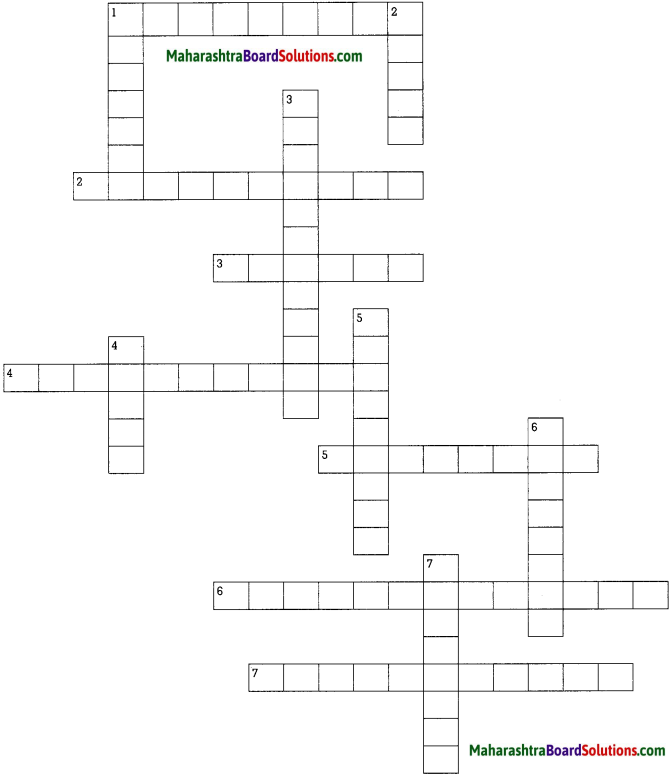Balbharti Maharashtra State Board Class 10 History Solutions Chapter 3 Applied History Notes, Textbook Exercise Important Questions and Answers.
Maharashtra State Board Class 10 History Solutions Chapter 3 Applied History
Question 1.
(a) Choose the correct option from the given options and complete the statement.
(1) The earliest museum in the world was discovered in the excavations at the city of ……………..………. .
(a) Delhi
(b) Harappa
(c) Ur
(d) Kolkata
Answer:
(c) Ur
![]()
(2) The National Archives of India is in ……………..………. .
(a) New Delhi
(b) Kolkata
(c) Mumbai
(d) Chennai
Answer:
(a) New Delhi
(b) Identify and write the wrong pair in the following set.
(1) Kootiyattam- Sanskrit theatre, Kerala
(2) Ramman- Dance form in West Bengal
(3) Ramlila- Traditional Performance of the Ramayana in Uttar Pradesh
(4) Kalbelia- Folk songs and dances of Rajasthan.
Answer:
(2) Wrong pair: Ramman – Dance form in West Bengal
Question 2.
Explain the following concepts :
(1) Applied History
Answer:
- When one subject is applied to different fields and conclusions are derived, it is known as application of that subject.
- When objectives of History are applied to other subjects; new conclusions are obtained.
- This is known as ‘Applied History’. It is also known as Public History.
- We get insights of the events that took place in the past through history.
- Applied History is concerned with application of knowledge of history to provide guidance in finding solutions.
- Contemporary social issues and include them in social planning.
- Thus Applied History’ is a field of study concerned with the application of history for the benefit of people in contemporary and future times.
![]()
(2) Archives
Answer:
- A place where historical documents are preserved is called an ‘Archive’.
- Many old documents, official records, old films, records of treaties are kept at this place.
- We get references of original documents because of Archives.
- A study of historical events of a particular period is possible.
- We come to know about language, script used in a particular period/era.
- The National Archives of India is in Delhi. It is the largest Archive in Asia.
- Every state in India maintains its archives independently.
Question 3.
Complete the following concept chart.

Answer:
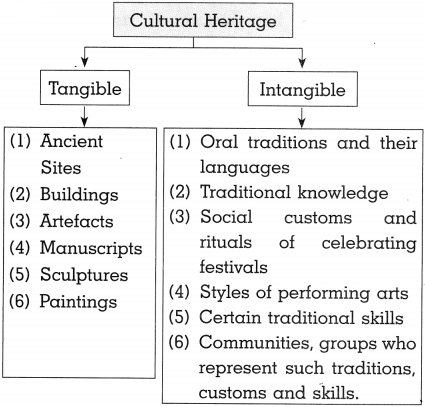
Question 4.
Explain the following statements with reasons.
(1) It is essential to study the history of technology.
Answer:
- Man acquired different skills at various stages in his evolution process.
- From mxking stone tools to developing new techniques of agriculture production, he learnt many skills and entered in the age of science.
- Agricultural production, commodity production, architecture, engineering, etc.
- underwent several changes. Production increased manifold bcause of technology.
- Hence, it is necessary to know the history of technology in order to understand the development in mechanisation and mutual dependence between science and technology.
![]()
(2) The list of world Heritage Sites is announced by UNESCO.
Answer:
- Cultural heritage is a form of human creation. It is a cultural treasure that has been inherited from our ancestors.
- We feel connected to it and hence preserve and conserve it.
- This heritage is our asset that binds us to our past and hence we should preserve it for the benefit of future generations.
- In order to save this heritage, UNESCO has announced some directives.
- On the basis of those directives, list of sites, and traditions are declared as ‘World Heritage’.
- It has helped us in promoting these sites as tourist places.
Question 5.
Write elaborate answers
(1) How is the method of history useful in the research of
(a) Science
(b) Arts
(c) Management Studies
Answer:
Each field has its own history of building’ knowledge. The direction of development in every field is dependent on the stcrte of available knowledge in that field. The method of history has proved valuable in the research of various fields.
(a) Science: Scientific discoveries /invenfions take place because of humdn efforts to satisfy needs and curiosity. These efforts are based on scientific knowledge that already existed. Knowledge of the history of science helps in understanding the reasons, chronology and factors that facilitated a scientific invention/discovery. Knowledge of history of science helps in every field.
(b) Art: Development of any style of art lies in their expression through intellectual, emotional and cultural traditions. While studying any art form we have to understand the history of its traditions, the key to the expressions in it, and emotional temperament of the artist. Prevalent art style in the given period can be understood with the help of cultural history.
(c) Management Studies: All components like means of production, human resources, processes of production, the chain of market and sales, etc. are interrelated and require management.
Different social and economic institutions are involved in these industrial and commercial processes. Knowledge of similar functional systems of the past is essential to bring about changes, improvements and make the management smooth and efficient. It becomes necessary to know its history.
(2) How can we correlate applied history with our present?
Answer:
History gives us knowledge about the events that happened in past. Applied history helps us in understanding how the knowledge can be put to use for our benefit as well as for the benefit of future generations. Applied history is correlated with our present in the following ways:
(1) Knowledge of our past helps us in deciding our course of action in present. The.heritage of our ancestors exists in tangible and intangible- form. We have the curiosity to know more about our part because they represent the creative thoughts and traditions of that period.
(2) With the help of applied history we can not only come to know about the heritage but also conserve and preserve it.
(3) We can be better equipped to face social challenges in the present because the knowledge of history can provide guidance in finding solutions to contemporary social issues and incorporate them in the ’social planning.
(4) The direction of future development is S decided when we rightly analyse our present with our knowledge of the past acquired through applied history.
![]()
(3) Suggest at least 10 solutions for the preservation of the sources of history.
Answer:
There are three types of sources which are used to study history. They are written, oral and material sources. These sources are preserved in different ways. According to me, the following measures should be taken to preserve the sources:
- A regular repair and maintenance work of forts, memorials and palaces should be carried out. Timely action should be taken to avoid vandalisation of historic and public places.
- Historical coins, weapons should be handled with precaution and utmost care. They should be kept in a safe place to avoid the possibility of theft.
- Social awareness regarding the conservation and preservation of our cultural and natural heritage should be created. People will develop affinity towards the heritage and feel connected.
- Variations in environment and climatic conditions pose a threat to monumental structures. Humidity, dampness, moulds and pollution cause irrevocable damage to manuscripts, rare artefacts, statues, coins, etc.
- To protect them, special arrangements have to be made like rooms with controlled temperature or sanitising and detoxing the rooms.
- Oral literature like owis, folk songs should be compiled and written down.
- Public training programmes should be conducted for understanding the importance of history.
- Experts from different fields should be involved in preservation and conservation projects. S Stringent laws should be enacted to protect the monuments.
- Above all, people’s participation in conservation and preservation process is paramount.
(4) What objectives can be fulfilled through the heritage projects.
Answer:
The following objectives can be fulfilled through the heritage projects:
- Preservation, conservation and development of heritage sites can be done without any change in its original state/ structure.
- The local social structure and psychology of the local people, challenges they face in the present situations and their expectations can be surveyed.
- In the process of completing the project of conservation, preservation and development of a heritage site due precaution should be taken to avoid hurting the sentiments of the local people.
- Participation of the local people in the proposed project can be facilitated.
- In order to engage and employ the local skills in a creative way and create better opportunities of livelihood, it becomes easier to design systematic plans.
Project
Show the Indian heritage sites on the map of India.
Answer:
Memory Map
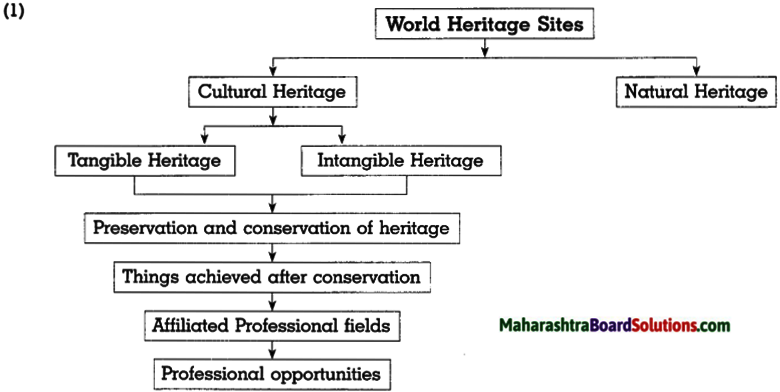
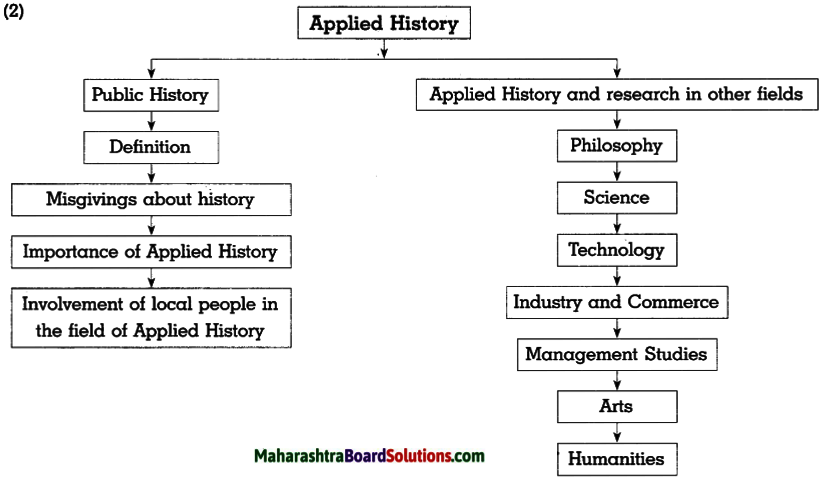
Question 6.
Complete the sentences by choosing the correct option:
(a) ……………………… Institute of Art, Design and Technology at Bengaluru has an independent department named ‘Centre for Public History’.
(a) Pitch
(b) INTACH
(c) Shrushti
(d) AIMS
Answer:
(c) Shrushti
![]()
(b) ……………………… is the mother of science and all other branches of knowledge.
(a) Philosophy
(b) History
(c) Technology
(d) Mythology
Answer:
(a) Philosophy
(c) In order to preserve and conserve cultural and natural heritage for the benefit of future generations ……………………… has given directives.
(a) UNICEF
(b) UN
(c) UNESCO
(d) INTACH
Answer:
(c) UNESCO
(d) The ……………………… in the Satara District of the Western Ghats is included in the list of World Natural Heritage.
(a) Balaghat Mountain
(b) Melghat
(c) Masai Plateau
(d) Kas Plateau
Answer:
(d) Kas Plateau
(e) The main office of the National Film Archives of India is situated at ……………………… .
(a) Delhi
(b) Mumbai
(c) Pune
(d) Nagpur
Answer:
(c) Pune
(f) Excavations at the city of ‘Ur’ in Mesopotamia were conducted by ……………………… .
(a) Nathaniel Wallick
(b) Ennigaldi
(c) Leonard Wolley
(d) Sir John Marshall
Answer:
(c) Leonard Wolley.
Question 7.
Identify the wrong pair in the following, and write it:
| (1) Kootiyattam | (a) Sanskrit theatre, Kerala |
| (2) Ramman | (b) Dance form in West Bengal |
| (3) Ramlila | (c) Traditional performance of Ramayana in Uttar Pradesh |
| (4) Kalbelia | (d) Folk songs and dances of Rajasthan |
Answer:
Wrong pair: Ramman – Dance form in West Bengal
![]()
(2)
| Cultural Heritage | Place |
| (1) Red Fort | (a) Udaipur |
| (2) Jantar Mantar | (b) Jaipur |
| (3) Brihadeeshvara Temple | (c) Thanjavur |
| (4) Capital Complex | (d) Chandigarh |
Answer:
Wrong pair: Red Fort – Udaipur
Question 8.
Complete the graphical presentation:
(1)
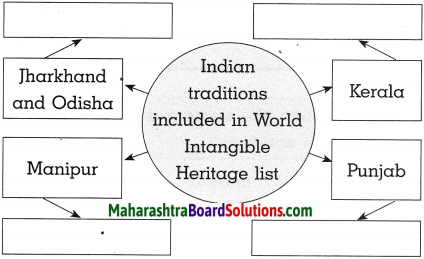
Answer:
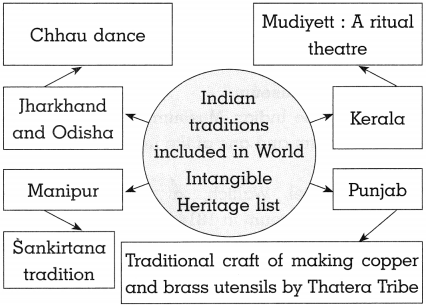
(2)
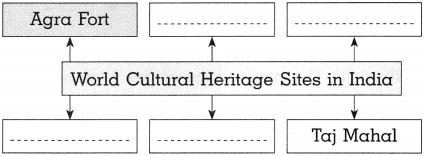
Answer:
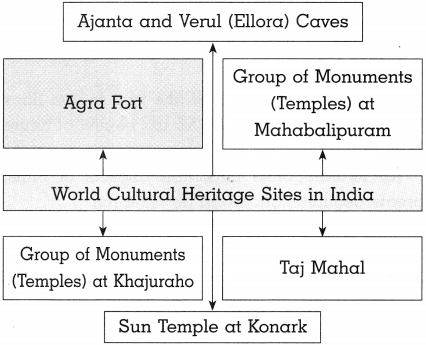
![]()
(3)
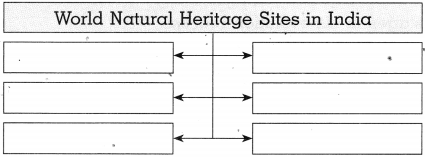
Answer:
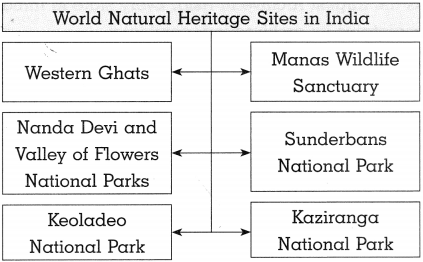
Question 9.
Explain the following concept:
(a) Natural Heritage:
Answer:
- In Cultural heritage what we inherit is man-made but Natural heritage is bestowed upon us by Nature.
- The concept of natural heritage gives importance to the thought of biodiversity.
- The following things are included in natural heritage:
- Fauna
- Flora
- Ecology required for sustaining animal and plant life, flora and fauna of a particular region.
- Geomorphic characteristics, sanctuaries, mountain ranges, river valleys, lakes and dams are all part of natural heritage.
Question 10.
Write short notes:
(a) Importance of Applied History:
Answer:
- Applied History is a field of study which helps us understand our ancient heritage.
- We realise the importance of preserving our heritage.
- The process of preservation and conservation of tangible and intangible heritage sites generate employment opportunities.
- The study of Applied History help us to get a better understanding of the present and can provide guidance for the future.
![]()
(b) Preservation of cultural heritage of India:
Answer:
Conservation and preservation of India’s cultural heritage is done at different levels:
- Archaeological Survey of India (ASI) is an important body of Indian government which mainly does the work of conservation and preservation along with State Departments of Archaeology.
- INTACH (Indiqn National Trust for Art and Cultural Heritage) is actively working in this field.
- Local self-government bodies, social institutions all over India, people who have love for history are seen involved in the work of preservation of our heritage.
- The work of conservation and preservation of cultural and natural heritage requires participation of experts from various fields as well as local people.
(c) Indian Museum:
Answer:
- The Indian Museum at Kolkata is the oldest museum and one of the important heritage sites of India.
- Nathaniel Wallich, a Danish botanist, founded the museum in 1814 C.E. He was also its first curator.
- The museum has three main departments Arts, Archaeology and Anthropology.
- Other affiliated departments are conservation, publication, photography, exhibition- presentation, model-making, training, library and security.
(d) National Film Archives:
Answer:
- The main office of the National Rim Archives of India is located at Pune and was established in 1964.
- It functions as the Media Unit of the Ministry of Information and Broadcasting of the Indian Government.
- It was established with the view of three objectives. They are:
- To search and obtain the rare Indian films and preserve our heritage for the benefit of future generations.
- To categorise important aspects of films, create documentation and do research.
- To establish a centre for dissemination of ‘films culture’.
Question 11.
Explain the following statements giving reasons:
(a) It is essential to study the history of philosophy.
Answer:
- With the passage of time, many schools of thought came into existence with different ideologies.
- These ideologies had their effect on people and society as a whole.
- What led to the origin of various ideologies, the intellectual tradition giving rise to those ideologies and their historical development needs to be researched.
- To know about the progress of those ideologies, their development and expansion or downfall we need to have knowledge of the history of philosophy.
(b) It is important to know the history of Industry and Commerce.
Answer:
- With the growth of industry and trade, the field of mutual social transactions also expand.
- It promoted development of the network of cultural interactions.
- As the nature of market and commerce changed sp did the nature of human relationships and the social organisation.
- This series of changes is influenced by prevalent culture, social structure and economic system.
- All this is an integral part of the industrial and commercial management.
Therefore, it becomes important to know the history of Industry and Commerce.
![]()
(c) It is necessary to preserve and conserve our natural and cultural heritage.
Answer:
- The visible and invisible relics of the past exist in the present.
- They represent the thought and traditions of our ancestors.
- We nurture some kind of curiosity and attraction towards them.
- The history of our heritage links us with our origin.
Therefore, it becomes necessary to preserve and conserve for our future benefit as well as for the benefit of future generations.
Question 12.
Answer the following in 25-30 words:
(a) Explain the concept of ‘Public History’.
Answer:
- Public History also known as ‘Applied History’ is a field of study concerned with the application of history for the benefit of people in the contemporary and future life.
- It provides solutions to the contemporary social issues and incorporate them in social planning.
- It helps to overcome misgivings about history and makes history meaningful in everyday life connecting people to history.
(b) What is the role of UNESCO in the context of heritage sites?
Answer:
The role of UNESCO, the global agency of United Nations, is as follows:
- For preservation and conservation of natural and cultural heritage which is in a ruined state because of years of neglect, UNESCO has announced some directive principles.
- The organisation announces list which includes the names of sites and traditions which meet the criteria.
- On the basis of those directives it declares a list of site and traditions of world heritage.
(c) Find out the cultural heritage sites located in Maharashtra and write their names.
Answer:
The following places in Maharashtra are included in the list of cultural heritage sites declared by UNESCO:
- Ajanta Caves
- Verul (Ellora) Caves and Kailas Temple
- Elephanta Caves
- Chhatrapati Shivaji Maharaj Terminus, Mumbai.
Many forts like the Raigad, Devgiri, Janjira and Sindhudurg are part of the cultural heritage Of Maharashtra though they are not included in the list.
(d) What are the misgivings about history among the people?
Answer:
There are many misgivings about history among the people:
- History is a subject only for historians and students who pursue higher studies in history.
- It has no relevance or applicability in our day-to-day life.
- History is nothing but piece of information about the battles fought by kings and politics.
- History cannot be connected to an economically productive field.
![]()
(e) Where can we trace the roots of philosophy?
Answer:
- Ancient people all over the world tried to speculate the relationship between the universe and human existence.
- This gave rise to various myths about origin of this world, universal order, human life.
- Imagination about gods and goddesses, rituals to please them and philosophical explanation of rituals.
- Thus, the roots of philosophy can be traced in these speculations and ponderings of mythological stories.
(f) What are the opportunities created by affiliated professional fields of Applied History?
Answer:
Affiliated fields of Applied History which include museums, archives, tourism ‘and hospitality, entertainment, mass media, etc. needs the following professionals:
- Experts like Historians, Archaeologists, Sociologists, legal experts, etc. are assigned new projects.
- Officers like Managers, Secretaries and Directors are taken into service.
- Technicians like engineers, architects, skilled photographers, laboratory assistants, archive management professionals are hired.
- Tourist guides, boarding and lodging, food services, entertainment and related business get a wide scope for flourishing.
(g) What are the main objectives of ‘National Film Archives’?
Answer:
The main objectives of ‘National Rim Archives’ are as follows:
- To research and obtain the rare Indian films.
- To preserve such films for the benefit of future generations.
- To categorise the important aspects of films to create documentation, catalogue them -and carry out research in the field.
- To establish a centre for dissemination of films culture.
(h) How can we increase people’s participation in the field of applied history?
Answer:
- The field of applied history includes museums, archives, collection and maintenance of artefacts.
- Tourism creates interest in history.
- Awareness is created among people to preserve ancient monuments and sites in their vicinity.
- This realisation increases people’s participation in the field of applied history.
(i) Write information on World Heritage sites in Maharashtra.
Answer:
Maharashtra is endowed with many natural and historical sites. Among them the prominent ones are Ajanta caves, Verul caves, Gharapuri/Elephanta caves and Chhatrapati Shivaji Maharaj Terminus Railway Station at Mumbai.
Chhatrapati Shivaji Maharaj Terminus is finest example of Indo-Gothic architecture emerged in India during British rule. It stands witness to the British empire, freedom struggle and transformation of our country into a modern nation. It needs conservation as it a architectural marvel which stood the test of times recently when there was a terror attack on Mumbai city.
![]()
(j) What is the role of Applied History?
Answer:
The role of Applied History is as follows:
- In public training programmes for understanding the importance of history.
- Using knowledge of history, to create awareness regarding the conservation and preservation of our cultural and natural heritage.
- To facilitate participation of people in various projects and programmes related to applied history even in their capacity as tourists.
- To enhance professional skills of people and to develop industrial commercial field.
- To carry out preparatory work and plan for effective implementation of heritage projects.
Question 13.
Read the given passage carefully and answer the questions given below:
(a) Who built this museum?
Answer:
This museum was built by Ennigaldi, the princess of Mesopotamia.
(b) Where was the earliest museum in the world discovered? Who discovered it?
Answer:
The earliest museum in the world was discovered in the city of ‘Ur’ in Mesopotamia. It was discovered by Leonard Woolley.
(c) What is a noteworthy feature of this museum?
Answer:
A noteworthy feature of this museum is the clay tablets inscribed with the descriptions of exhibited artefacts.
Question 14.
Write elaborate answers: OR Answer in detail:
(a) Who does the work of conservation and preservation of the cultural heritage of Indian?
Answer:
The preservation and conservation of Indian cultural heritage is done at various stages:
- The work of preservation and conservation primarily falls under jurisdiction of the Archaeological Survey of India.
- In addition, INTACH (Indian National Trust for Art and Cultural Heritage) is also actively working .in this field.
- Experts from various fields and local people too participate in the work of conservation and preservation of natural and cultural heritage.
Question 15.
Observe the picture and write information about it:
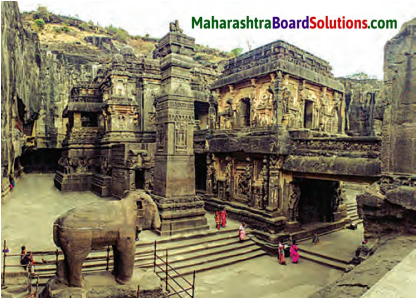
Answer:
- This picture is of the largest Indian rock-cut ancient Hindu temple located in the Ellora cave.
- This famous rock-cut Shiva temple was constructed during the reign of Rashtrakuta king Krishna I.
- It is regarded as a marvel of architecture.
- It bears an eloquent testimony to the high level skill attained by India in the arts of sculpture and architecture under the Rashtrakuta patronage.
- A sculpture of an elephant and a pillar can be seen in the picture.
- The famous rock cut temple in Maharashtra was declared as a world heritage site by UNESCO in 1983.
![]()
Brain Teaser
Hints:
Across:
(1) Queen’s stepwell at Patan
(2) Dancing, singing, drumming ritual of Manipur
(3) Religious festival and ritual theatre of Garhwal
(4) Archaeological site of Nalanda University
(5) World famous monument at Agra
(6) Famous city built by emperor Akbar marking his victory
(7) Sanskrit Theatre: Kerala
Down:
(1) The traditional performance of Ramayan in Uttar Pradesh
(2) Ellora caves also known as caves
(3) Observatory at Jaipur, Rajasthan
(4) Group of monuments at (place) in Karnataka
(5) Archaeological park at Pavagadh
(6) Folk songs and dances of Rajasthan
(7) A ritual theatre of Kerala
